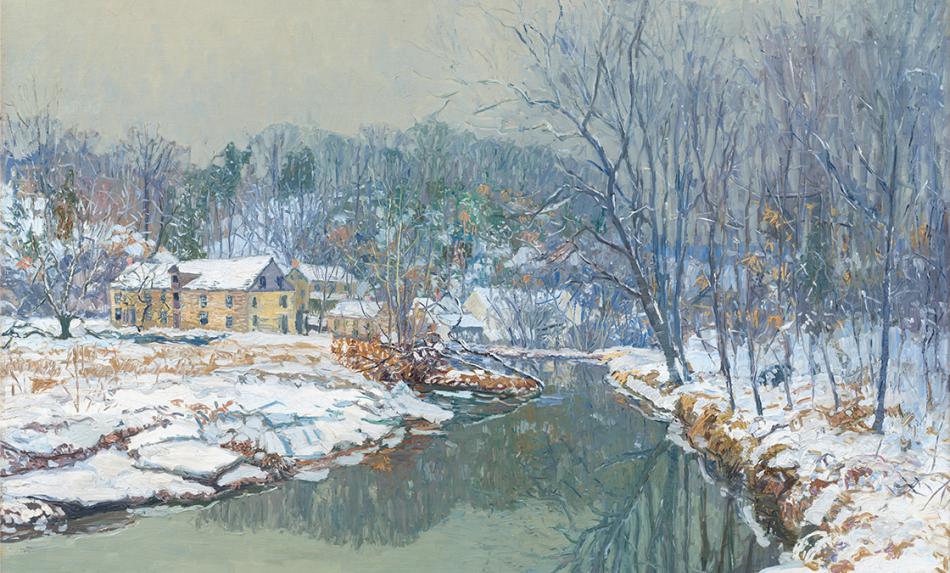A Scene on the Ice
c. 1625
Hendrick Avercamp
Artist, Dutch, 1585 - 1634
Rich and poor mingle on the frozen waters of a river. From the lower left corner, a man quietly observes the many skaters. At the center, well-dressed ladies ride in an elegant sleigh driven by a groom; the horse’s shoes are spiked for traction on the slippery surface. Two little boys in the right corner play a game of colf (or kolf), a cross between modern-day hockey and golf. And in the background, sledges transport people and commercial goods on the frozen waterway.
Avercamp, who combined the Dutch love of landscape with scenes of daily life, was among the first European artists to specialize in depictions of winter. The pearly gray tonality here becomes ever paler and the forms less distinct as they move into the distance, subtly conveying a sense of deep space on a frosty day. The setting may be the IJssel River at Kampen, the Hanseatic town northeast of Amsterdam where Avercamp resided most of his life. Mute since birth and likely deaf as well, Avercamp was called "de Stomme van Kampen," meaning "the Mute of Kampen." Despite this disability, Avercamp had a successful and independent career as a painter of popular winter scenes.

West Building Main Floor, Gallery 44
Artwork overview
-
Medium
oil on panel
-
Credit Line
-
Dimensions
overall: 39.2 x 77 cm (15 7/16 x 30 5/16 in.)
framed: 64.8 x 102.2 x 5.7 cm (25 1/2 x 40 1/4 x 2 1/4 in.) -
Accession Number
1967.3.1
More About this Artwork

Video: Wintertime Art Screensaver
Enjoy relaxing music and a series of wintertime landscapes from our collection.
Artwork history & notes
Provenance
Said to have been at the Imperial Hermitage Gallery, Saint Petersburg.[1] (Firma D. Katz, Dieren), by 1933; J.M.B. Beuker, Heelsum, by 1934;[2] by inheritance to his widow, Mrs. J.C. Beuker [née De Kruyff van Dorssen]; sold 5 April 1967 through (A. Martin de Wild, The Hague) to NGA.
[1] In the catalogues for the 1934 and 1938 exhibitions in which it was included, the painting was described as having been previously in the collection of the Hermitage. However, the picture is not listed in any of that museum's collection catalogues.
[2] Labels from the 1933 and 1934 exhibitions both say that Katz was the “exhibitor,” but they give two different names as the “owner” (removed from the back of the painting, now in NGA curatorial files). The owner’s name on the 1933 label is difficult to decipher, but appears to be two initials followed by “te H.” The owner’s name on the 1934 label clearly reads “J.M.B. Beuker Heelsum.”
Associated Names
Exhibition History
1933
Kunsttentoonstelling van 17e Eeuwsche Schilderijen, Gemeentelijk Museum, Zutphen, The Netherlands, 1933, no. 45.
1934
Tentoonstelling van Schilderijen van Oud-hollandsche Meesters uit de Collectie Katz te Dieren, Frans Halsmuseum, Haarlem, 1934, no. 45.
1938
Meesterwerken uit Vier Eeuwen 1400-1800, Museum Boymans-van Beuningen, Rotterdam, 1938, no. 52.
1969
In Memoriam, Ailsa Mellon Bruce, National Gallery of Art, Washington, D.C., 1969, unnumbered checklist.
1997
Rembrandt and the Golden Age: Dutch Paintings from the National Gallery of Art, The Chrysler Museum of Art, Norfolk, Virginia, 1997, unnumbered brochure.
2018
Water, Wind, and Waves: Marine Paintings from the Dutch Golden Age, National Gallery of Art, Washington, D.C., 2018, unnumbered brochure.
Bibliography
1934
Niehaus, Kasper. "Oudhollandsche meesters in het Frans Halsmuseum." De Telegraaf, 29 (November 1934): 7.
W., J. "Een Collectie der Firma D. Katz te Haarlem." Nieuwe Arnhemsche Courant (22 November 1934).
1938
Hannema, Dirk. Meesterwerken uit vier eeuwen, 1400-1800. Exh. cat. Museum Boymans, Rotterdam, 1938: no. 52.
1968
European Paintings and Sculpture, Illustrations. National Gallery of Art, Washington, 1968: 2, repro.
1975
European Paintings: An Illustrated Summary Catalogue. National Gallery of Art, Washington, 1975: 14, repro.
1978
King, Marian. Adventures in Art: National Gallery of Art, Washington, D.C. New York, 1978: 54, 56-57, pl. 32.
1979
Welcker, Clara J. Hendrick Avercamp (1585-1634), bijgenaamd "De Stomme van Campen" en Barent Avercamp (1612-1679), "Schilders tot Campen". Edited by D.J. Hensbroek-van der Poel. Rev. ed. Doornspijk, 1979: 216, no. S73.3.
1982
Blankert, Albert. Hendrick Avercamp, 1584-1634; Barent Avercamp, 1612-1679; Frozen Silence: Paintings from Museums and Private Collections. Exh. cat. Waterman Gallery, Amstersdam; Provenciaal Overijssels Museum, Zwolle. Amsterdam, 1982: 55 n. 25.
1984
Walker, John. National Gallery of Art, Washington. Rev. ed. New York, 1984: 287, no. 372, color repro.
1985
National Gallery of Art. European Paintings: An Illustrated Catalogue. Washington, 1985: 33, repro.
1986
Sutton, Peter C. A Guide to Dutch Art in America. Washington and Grand Rapids, 1986: 305, repro.
1995
Wheelock, Arthur K., Jr. Dutch Paintings of the Seventeenth Century. The Collections of the National Gallery of Art Systematic Catalogue. Washington, 1995: 9-14, color repro. 11.
2001
Spolsky, Ellen. Satisfying Skepticism: Embodied Knowledge in the Early Modern World. Burlington, 2001: 146-147, fig. 7.3.
2009
Roelofs, Pieter, ed. Hendrick Avercamp: Master of the Ice Scene. Exh. cat. Rijksmuseum, Amsterdam; National Gallery of Art, Washington. Amsterdam, 2009: 107, 169 n. 39.
2021
Kennicott, Philip and Matthew Cappucci. "Examining the Elements of Breathtaking Art." Washington Post 144, no. 225 (July 18, 2021): E10, color repro.
Inscriptions
lower left, in ligature: HA
Wikidata ID
Q20177057





